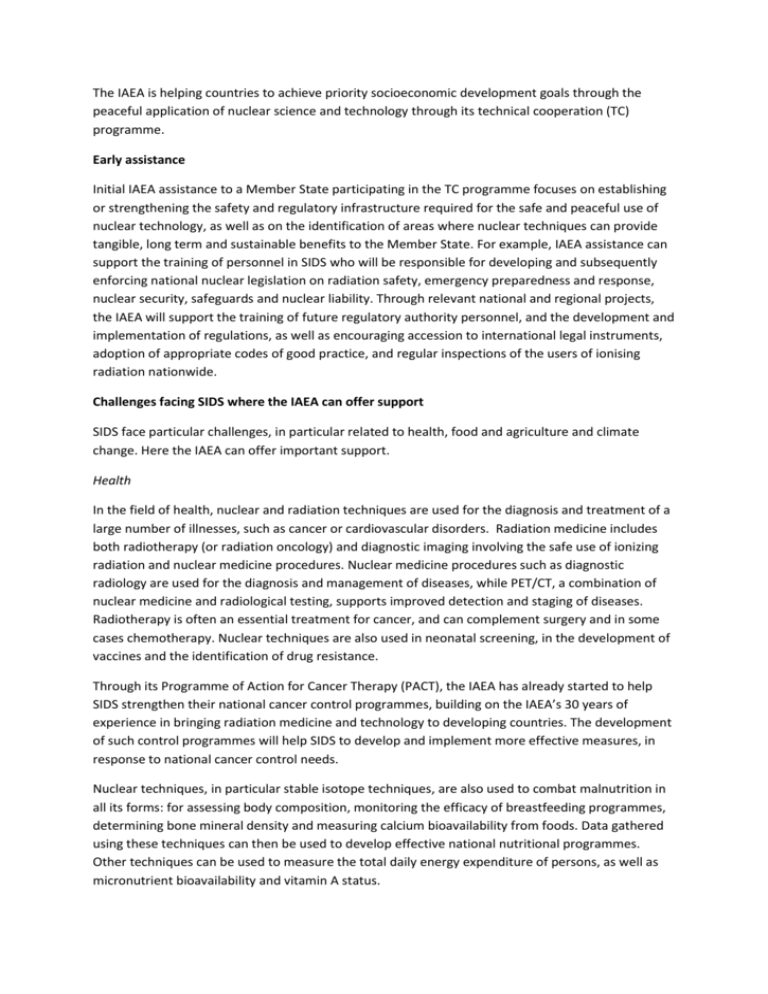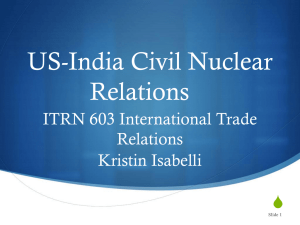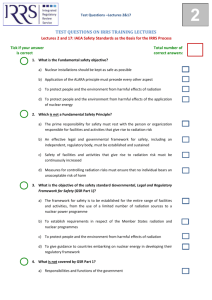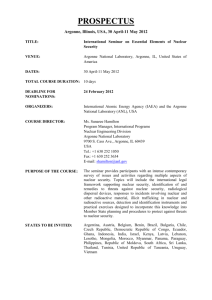The IAEA is helping countries to achieve priority socioeconomic
advertisement

The IAEA is helping countries to achieve priority socioeconomic development goals through the peaceful application of nuclear science and technology through its technical cooperation (TC) programme. Early assistance Initial IAEA assistance to a Member State participating in the TC programme focuses on establishing or strengthening the safety and regulatory infrastructure required for the safe and peaceful use of nuclear technology, as well as on the identification of areas where nuclear techniques can provide tangible, long term and sustainable benefits to the Member State. For example, IAEA assistance can support the training of personnel in SIDS who will be responsible for developing and subsequently enforcing national nuclear legislation on radiation safety, emergency preparedness and response, nuclear security, safeguards and nuclear liability. Through relevant national and regional projects, the IAEA will support the training of future regulatory authority personnel, and the development and implementation of regulations, as well as encouraging accession to international legal instruments, adoption of appropriate codes of good practice, and regular inspections of the users of ionising radiation nationwide. Challenges facing SIDS where the IAEA can offer support SIDS face particular challenges, in particular related to health, food and agriculture and climate change. Here the IAEA can offer important support. Health In the field of health, nuclear and radiation techniques are used for the diagnosis and treatment of a large number of illnesses, such as cancer or cardiovascular disorders. Radiation medicine includes both radiotherapy (or radiation oncology) and diagnostic imaging involving the safe use of ionizing radiation and nuclear medicine procedures. Nuclear medicine procedures such as diagnostic radiology are used for the diagnosis and management of diseases, while PET/CT, a combination of nuclear medicine and radiological testing, supports improved detection and staging of diseases. Radiotherapy is often an essential treatment for cancer, and can complement surgery and in some cases chemotherapy. Nuclear techniques are also used in neonatal screening, in the development of vaccines and the identification of drug resistance. Through its Programme of Action for Cancer Therapy (PACT), the IAEA has already started to help SIDS strengthen their national cancer control programmes, building on the IAEA’s 30 years of experience in bringing radiation medicine and technology to developing countries. The development of such control programmes will help SIDS to develop and implement more effective measures, in response to national cancer control needs. Nuclear techniques, in particular stable isotope techniques, are also used to combat malnutrition in all its forms: for assessing body composition, monitoring the efficacy of breastfeeding programmes, determining bone mineral density and measuring calcium bioavailability from foods. Data gathered using these techniques can then be used to develop effective national nutritional programmes. Other techniques can be used to measure the total daily energy expenditure of persons, as well as micronutrient bioavailability and vitamin A status. Food and agriculture In the area of food and agriculture, the IAEA’s Joint Division with the Food and Agriculture Organization delivers important support through coordinated research projects and technical cooperation activities. Induced crop mutation, which uses nuclear techniques to speed up the natural process of crop evolution, can lead to the development of higher-yielding or salt-tolerant crops, or crops with greater resilience to climate variability, disease or insect pests. Nuclear techniques can also be used to improve livestock, supporting improved artificial insemination and enhanced feeding programmes. The IAEA-supported Sterile Insect Technique (SIT), where irradiated, sterile male insects are released to compete with wild insects, can be integrated with other pest suppression methods to reduce and eradicate insect pests such as tsetse, fruit fly, and cactus moth. Water and the environment Nuclear science and technology also play a key role in improved soil and water management, helping to identify the complex relationship between soil, water and fertilizer, and supporting the implementation of more efficient farming and irrigation practices. IAEA projects help Member States develop national resilience to the impact of climate change, which is manifested in unpredictable and more extreme weather events, encroaching salinity, and soil degradation – all challenges that face SIDS. Isotope hydrology, which allows precise identification of water sources and pathways, can contribute significantly to sustainable water management. Such techniques provide the basic data and information needed to plan, develop and rationally exploit ground and surface water resources. Waste management Countries applying nuclear techniques – using radiotherapy machines, for example, or providing X rays – will need support in radioactive waste management. Here IAEA assistance is essential for dealing effectively with disused radioactive sources, and where necessary for designing and implementing alternative conditioning and storage solutions. Such assistance includes support to establish a reliable inventory of radioactive sources, develop relevant legislation and regulations and build national human resource capacity, as well as guidance to establish centralized storage facilities for disused radioactive sources. Ocean monitoring, coastal zone management and climate change The IAEA’s Environment Programme is engaged in a variety of activities that support, or potentially could support, the sustainable development and food security of Small Island Developing States (SIDS). The IAEA Marine Environment Laboratories in Monaco carry out applied research to develop nuclear techniques to assess processes and changes that affect the marine environment, offer training for Member States in the use of such techniques, and provide analytical services and support for Member States and their laboratories. These activities address topics relevant to sustainable development and food security such as the impact of climate change on the world’s oceans, the sources, pathways and impacts of a variety of pollutants, and the effects of radioactivity on marine ecosystems and biota. Presently, these are all areas of concern for SIDS. Climate change is a primary concern for SIDS, and the marine environment laboratories are increasingly active in responding to the numerous challenges that climate change presents. For example, the laboratories help Member States to use nuclear techniques to study carbon pathways and concentrations in the oceans to assess climate change processes and their impacts on the marine environment. For those Member States that do not have the resources to support their own marine environment laboratories, which may include some SIDS, the laboratories can provide analytical services to respond to this need. Ocean acidification is a key climate change issue that can affect SIDS through its impact on marine species that are vital sources of food and income. The oceans represent the primary source of food for 3.5 billion people, and the changes to marine chemistry that are being caused by ocean acidification can disrupt the habitats and food chains for species that supply up to one-third of all protein consumed by humans. Recognizing the need for collaboration to respond to this growing problem, the Agency established the Ocean Acidification International Coordination Centre (OA-ICC) last year at its laboratories in Monaco. The OA-ICC works to communicate on, promote and facilitate global activities on ocean acidification, and includes among its partners UNESCO, FAO, the U.S. National Oceanic and Atmospheric Administration, the Fondation Prince Albert II de Monaco and leading scientists and economists in the field. Climate change and ocean acidification have also increased the frequency and danger of harmful algal blooms (HABs), which can threaten coastal fisheries important to the sustainable development and food security of SIDS. Accordingly, the Agency’s marine laboratories support technical cooperation projects that are designed to help Member States detect, measure and manage the toxicity of HABs. Member States participating in these projects include Cuba, the Dominican Republic, Haiti, Madagascar and Mauritius. Regarding pollution sources, pathways and impacts, the laboratories in Monaco cooperate with UNEP and other UN agencies in planning and implementing monitoring programmes, and could design a coordinated regional monitoring programme to help SIDS assess marine pollution. For example, this could involve assisting in the analysis of mercury and persistent organic pollutants (POPs) in environmental samples and seafood to protect human health and the marine environment. Such support could also help SIDS to fulfil their international obligations, e.g., with respect to the Minamata Convention on Mercury and the Stockholm Convention on POPs. Lastly, the nuclear accident at the Fukushima Daiichi power plant highlighted the importance of capabilities for assessing the impacts of radioactive releases on marine ecosystems and biota. The Agency’s marine laboratories are responding to this need through a regional technical cooperation project that aims to establish a monitoring programme for Member States in the Asia-Pacific region.






